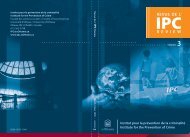0306E - Faculty of Social Sciences - Université d'Ottawa
0306E - Faculty of Social Sciences - Université d'Ottawa
0306E - Faculty of Social Sciences - Université d'Ottawa
Create successful ePaper yourself
Turn your PDF publications into a flip-book with our unique Google optimized e-Paper software.
Mariano (1995) test which tests wheather the models are statistically providing<br />
equally accurate forecasts. The test is applied as follows. Let ey i;t+mjt<br />
and ey j;t+mjt be the …rst and second ranking model for a series, the Diebold<br />
and Mariano test tests the null hypothesis <strong>of</strong> equal forecast accuracy for<br />
arbitrary loss function g(e i;tjt ); where e i;tjt is the corresponding 1 step ahead<br />
forecast error for model i, e i;tjt = y t ¡ ey i;tjt¡h : The loss function is de…ned<br />
as d t = g(e i;tjt ) ¡ g(e j;tjt ); so that the null <strong>of</strong> forecast accuracy entails an<br />
F statistic that d t = 0: Given the vector <strong>of</strong> fd t g T+24<br />
t=T<br />
, the Diebold-Mariano<br />
statistic for testing the null hypothesis <strong>of</strong> equal forecast accuracy is given<br />
by<br />
d<br />
q<br />
[V (d)<br />
; (10)<br />
where d is the sample mean loss di¤erencial and [ V (d) is the variance <strong>of</strong> d:<br />
The third coloumn in Table A.5 (appendix A), provides the p ¡ values at<br />
5% signi…cance level <strong>of</strong> the null hypothesis that the …rst and second ranking<br />
model for each series have a model performance equal in favor <strong>of</strong> the one<br />
sided alternative that model i 0 s performance is better then model j 0 s: For<br />
all series we fail to reject the null hypothesis meaning that for each series<br />
the forecasting performances <strong>of</strong> the remaining ‘candidate’ models are equal.<br />
In this case we use the remaining ‘best’ models to …rst estimate and next<br />
forecast each series.<br />
As a last step, we compare the unweighted average <strong>of</strong> our model forecasts<br />
with the forecasts <strong>of</strong> a naive model, where the naive model forecast is simply<br />
the actual <strong>of</strong> last period ( by t+1naive = y t ): The fourth coloumn in Table A.5<br />
(appendix A) provides the ratio <strong>of</strong> the error by our forecasts to the forecast<br />
error <strong>of</strong> the naive forecasts, which are all below one. Convinced with the<br />
power <strong>of</strong> the remaining ‘candidate’ models for each series in explaing the<br />
actuals and that they perform better then naive forecasts, we proceed by<br />
estimating each ‘remaining’ model using the full sample (1984:01 - 2003:02)<br />
and forecasting for the long term (2015). The results <strong>of</strong> the estimates for<br />
each series are provided in Appendix C.<br />
4.1 Forecast Comparisons<br />
For each <strong>of</strong> our series we estimated and forecasted the ‘best’ models using the<br />
full sample. The ‘best’ models, selection criteria described above, provides<br />
us with more than one series <strong>of</strong> forecasts for each series which are used<br />
15
















